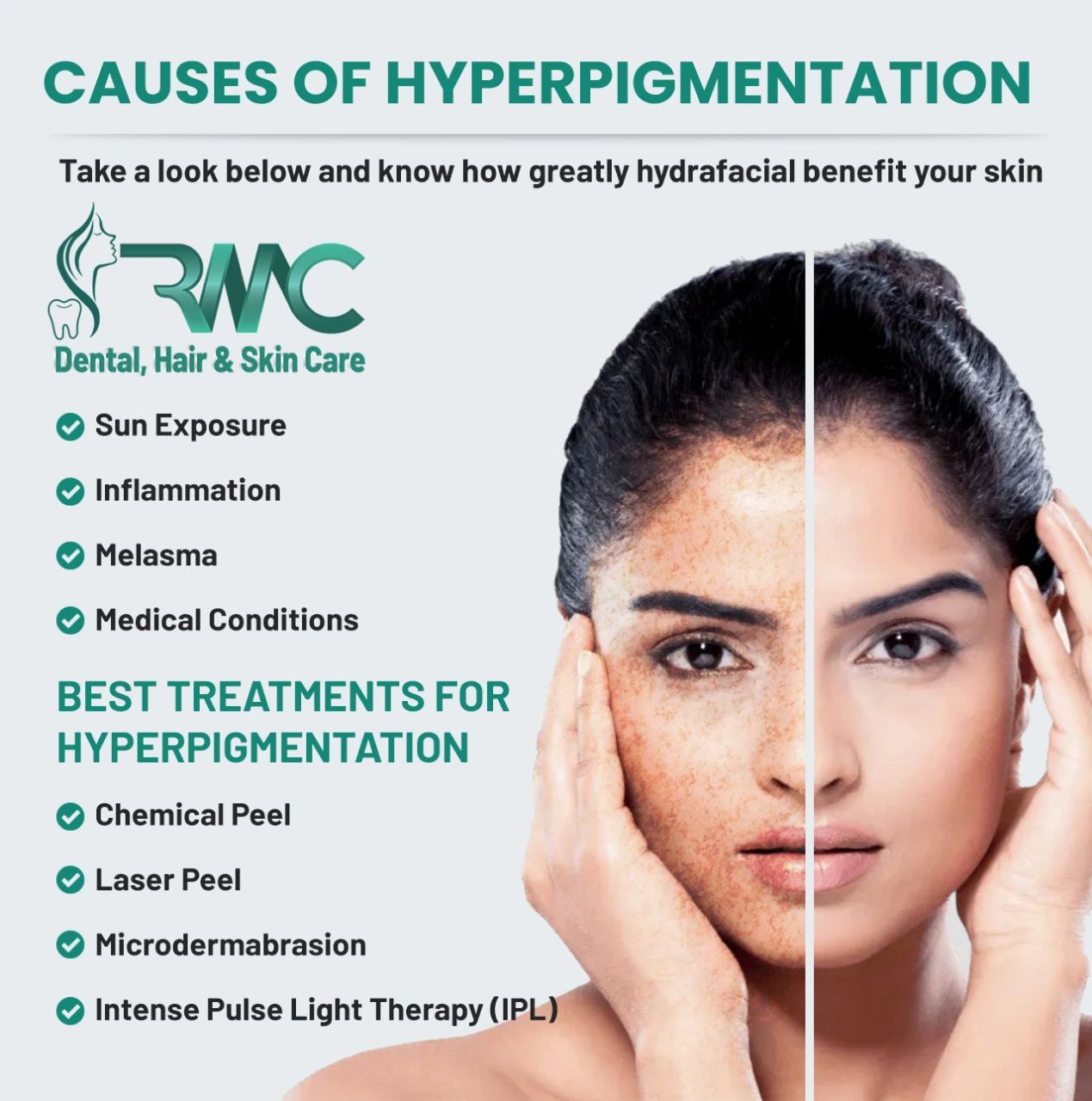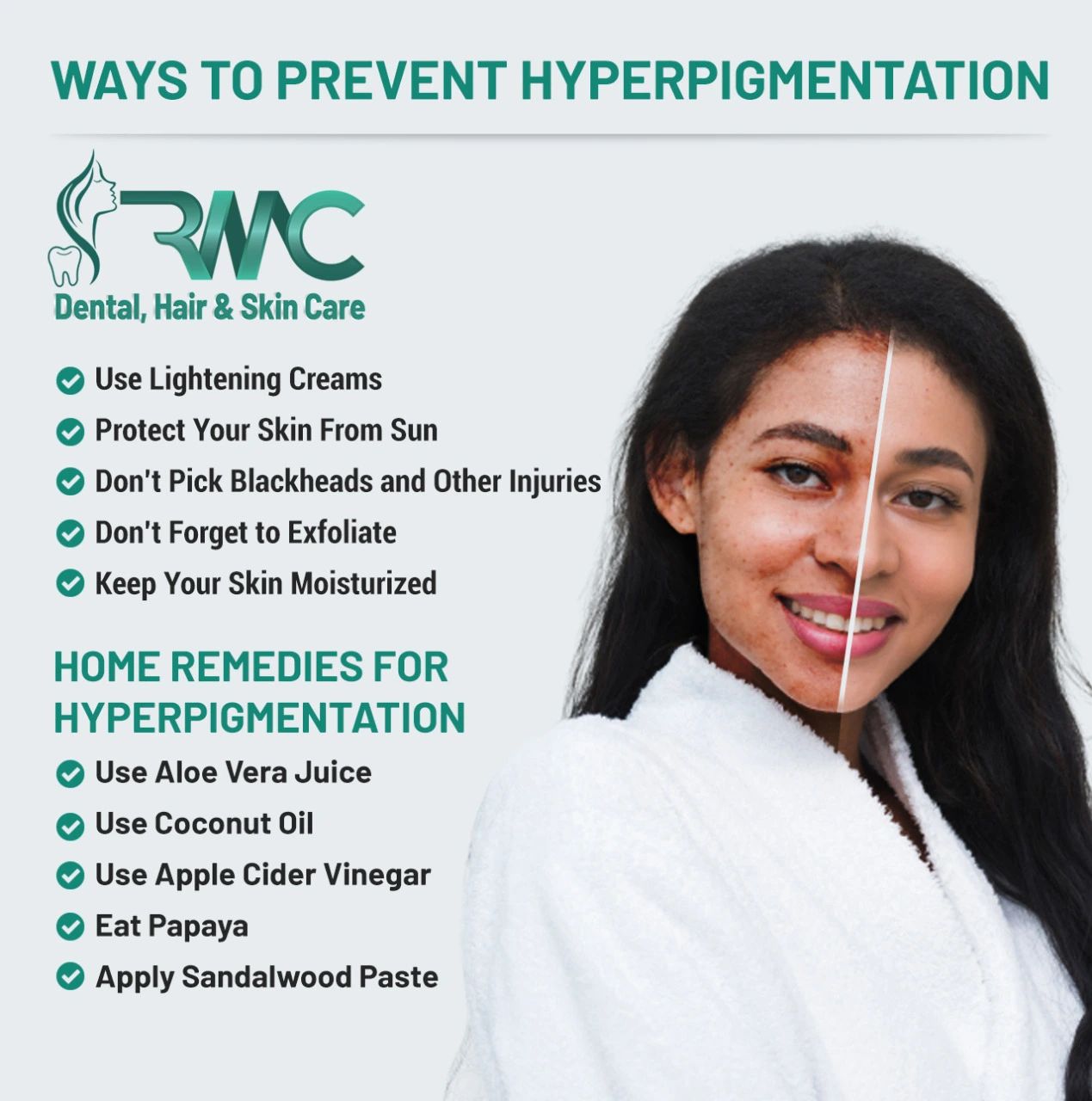Best Hyperpigmentation Treatments in Islamabad
Darker skin areas caused by excessive melanin production are referred to as hyperpigmentation in medical terms. Everything from acne scars and UV damage to hormonal changes can cause this.
There are several causes of hyperpigmentation on the skin, and it most frequently affects the parts of the body and face that are exposed to sunlight.
If you’re disturbed by dark patches on your skin caused by hyperpigmentation. So, stop worrying. You are not alone if you are struggling with hyperpigmentation. There are several ways to address this common skin problem. Different treatments are available depending on your hyperpigmentation type.
Keep reading this blog to understand more about it and the most effective ways to help you solve this issue.

Main Factors That Cause Hyperpigmentation
Depending on the underlying source of the hyperpigmentation, facial hyperpigmentation can arise at any age in people with any skin tone or type.
Below are some main factors that can cause hyperpigmentation, so look at them and understand them better.
-
Sun Exposure
The extra melanin is produced in response to the sun’s UV radiation to protect your skin from harm. You get a tan because of the increased melanin. However, excessive or regular sun exposure might result in the development of black sunspots.
Although sunspots are not dangerous, sun-exposed skin may acquire precancerous blemishes that resemble sunspots, according to the American Society for Dermatologic Surgery. This makes it crucial to have a dermatologist examine your skin.
-
Inflammation
Skin trauma can trigger inflammation, including acne, eczema, bug bites, wounds, and scrapes. In turn, inflammation can activate cells that produce pigment, leaving a dark area behind even after the damage has healed. Post-inflammatory hyperpigmentation is a common term used to describe a condition where inflammation is the root cause of discoloration.
-
Melasma
Melasma, sometimes known as the “mask of pregnancy,” is characterized by brown patches that typically appear in pregnant women and women with variable hormone levels. Although it can also happen in men, this hyperpigmentation most frequently affects females.
Since it has also been connected to the use of oral contraceptives, it is believed to be brought on by a mix of hormonal changes, genetics, and sun exposure.
There are many ways to treat face melasma, including over-the-counter lotions, hydroquinone-containing prescription skin care products, peels Off, Clear+ Brilliant laser treatment, and Cosmelan peels.
In many circumstances, lasers are not the best treatment for melasma since they might increase existing hyperpigmentation and melasma.
-
Medical Conditions
Addison’s disease, an adrenal gland illness that can increase melanin production, can result in hyperpigmentation. Antibiotics, nonsteroidal anti-inflammatory medicines (NSAIDs), and antimalarials are a few medications that may all raise the risk of hyperpigmentation.
Several chemotherapy medications might also result in transient hyperpigmentation. As new skin cells replace dead ones, the dark patches caused by chemotherapy medications often go away 10 to 12 weeks after treatment is finished.

Best Treatments to Prevent Hyperpigmentation
There are plenty of treatments available to prevent hyperpigmentation. The following scientifically proven treatments are;
-
Peel Off
When performing a peel Off, greater concentrations of acids are used to treat the targeted skin area. By eliminating the top layer of your skin, they lessen the appearance of hyperpigmentation (epidermis). In order to achieve more dramatic results, deeper versions may pierce the dermis, the middle layer of your skin.
Peel Off might not be your treatment if you frequently spend time in the sun. This is because your skin becomes more susceptible to the sun’s rays after peeling Off.
The sun may worsen your hyperpigmentation if you don’t use enough sunscreen. Therefore, you must pay extra attention for at least a week after your peel Off treatment.
-
Laser Peel
Targeted light beams are used to lessen hyperpigmentation during a laser peel (resurfacing) procedure.
Two types of lasers are used;
Ablative Lasers: The most powerful laser procedures remove layers of your skin.
Non-ablative Lasers:
Non-ablative procedures target the dermis to promote the tightening effects of collagen formation.
Although ablative lasers are more powerful, there could be more side effects. Both remove components from your skin, so new skin cells regenerate tighter and more toned.
-
Microdermabrasion
Microdermabrasion is used to cure hyperpigmentation that solely affects the epidermis. Your dermatologist will perform the procedure using drill-like handheld equipment with a wire brush or another abrasive attachment. The epidermis is swiftly and delicately removed from your skin using the tool.
To get the best results, you might need several sessions. On superficial scars, microdermabrasion is most effective. You can ask your dermatologist for assistance in deciding if this treatment is appropriate for you. Additionally, it benefits those with lighter skin tones.
-
Intense Pulse Light Therapy (IPL)
A non-ablative (fractional) laser procedure is known as IPL therapy. IPL therapy, which is often referred to as a photo facial, encourages the dermis’s collagen to grow. Many sessions are required for better results.
IPL is used to treat pigmentation problems, but flat spots respond to it particularly well. The appearance of wrinkles, spider veins, and enlarged pores might also be lessened.
Your dermatologist can assist you in determining the cause of your hyperpigmentation and will also assist you in choosing the best treatment according to your skin condition.
Ways to Prevent From Hyperpigmentation
Below are some best ways that will help you to prevent your skin from hyperpigmentation.
-
Use Lightening Creams
Lightening creams use certain creams to help reduce pigmentation. In order to gradually lighten the skin, they are often applied once or twice daily. Gel-based topical whitening products are also available.
For flat areas like melasma or age spots, whitening lotions or gels work well. On the majority of skin types, they work well for spots or discoloration.
-
Protect Your Skin From Sun
Applying broad-spectrum sunscreen every day, even on cloudy or cool days, with an SPF of 30 or more, is the most efficient strategy to stop sun-induced discoloration.
Avoiding being outside between 10 a.m. and 2 p.m., when the sun is at its heaviest. You can also wear a wide-brim hat to shield your head, face, ears, and neck.
-
Don’t Pick Blackheads and Other Injuries
No matter how enticing it may be to squeeze a stubborn blackhead or itch a mosquito bite, keep in mind your mother’s advice to “Don’t pick!”. Scratching and picking would only worsen the inflammation responsible for skin discoloration.
-
Don’t Forget to Exfoliate
Never forget to exfoliate your skin. It will help you in fading your dark spots and hyperpigmentation.
-
Keep Your Skin Moisturized
While lightening the dark spots, your main objective is treating hyperpigmentation.
Many people observe hyperpigmentation but ignore it, which is risky because early-stage skin cancer might resemble a sunspot. It is crucial to consult a board-certified dermatologist for this reason.
Home Remedies for Hyperpigmentation
You can use these natural home facial treatments, which are quite successful, to treat hyperpigmentation at home. These include:
-
Use Aloe Vera Juice
Natural anti-inflammatory and anti-bacterial elements included in aloe vera gel help regenerate skin cells and revitalize the skin. Because of this, when applied to the dark spots, they gradually fade away with continued application, leaving behind renewed and healthy skin.
Apply a mixture of 2 tablespoons of aloe vera gel and 1/2 a teaspoon of honey on the affected area. To achieve fantastic effects, wait a while before washing it off.
-
Use Coconut Oil
Coconut oil has various health advantages. It can assist in removing dead skin cells and shields the skin from the sun’s damaging UV radiation. To deeply enter the skin’s layers, apply coconut oil to the affected skin and massage it.
Give it time to absorb by leaving it in the affected area for 20 to 25 minutes. Apply this at least three times a week for better effects, then wash your face with lukewarm water.
-
Use Apple Cider Vinegar
Apple cider vinegar is helpful in treating hyperpigmentation. It can be used every day.
-
Eat Papaya
Start eating papaya, which is full of enzymes, to get rid of hyperpigmentation naturally. This enzyme aids in skin exfoliation and the removal of dead skin cells. New skin cells will grow back once the epidermal layer’s cells have been removed. Grate some papaya and apply it to the affected area for the best results.
-
Apply Sandalwood Paste
Sandalwood helps in fading hyperpigmented areas. Sandalwood and rose water should be combined to create a paste for this. Apply this paste to your face and let it sit for 15 to 20 minutes. After drying, wash your face with lukewarm water.
These home remedies work the best, but sometimes many face several issues. So, in that case, it is best to consult a dermatologist.
A dermatologist can recommend the best treatment for your specific hyperpigmentation if you need more sophisticated treatments and procedures. They recommend the top skincare items to treat hyperpigmentation and prevent it from worsening.
Now, the common skin condition hyperpigmentation can be treated. So, schedule an appointment with Rehman Medical Center’s expert dermatologist if you have hyperpigmentation. They create a treatment strategy that is especially suited to your requirements.
So, why wait? Book your appointment now and get rid of hyperpigmentation.

